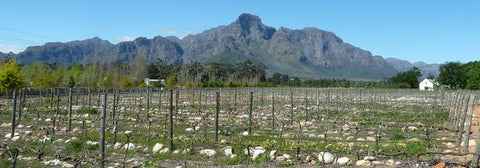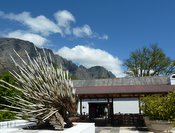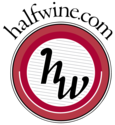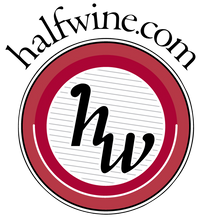Franschhoek
Notes from our trip to South Africa in 2012
Franschhoek has spectacular scenery, great restaurants, plenty of shops and lots of wineries; a great place to visit. Unfortunately the quality of the wine does not often live up to that of the scenery; and where it does the prices are what South Africans refer to a ‘tourist prices’.
Accommodation and meals
Maison Chablis
15 Berg Street, Franschhoek
Maison Chablis
We wanted to be able to walk to the restaurants and shops and Maison Chablis is ideally located for this; a quiet street a block or so from the main road. It is a B&B with wi-fi and a small dip-pool. The people running the place are very friendly and efficient. R1400 plus VAT per night. We definitely recommend it.
We wanted to eat at the iconic restaurant of Franschhoek is Le Quartier Francais (being one of San Pellegrino World's 50 Best Restaurants) but we didn’t do our research and it was closed on Monday. So we went to Le Bon Vivant instead.
Le Bon Vivant
la Rochelle Street Tel +27 21 876 2717 www.lebonvivant.co.za
Boekenhoutskloof 2007 Cabernet Sauvignon with steak
When we arrived at an empty Le Bon Vivant on Monday evening they asked if we had booked and when we said no, the person on the door did what all craftsmen do when they are about to give you a big bill. We were told that we were at the last table. When we left the restaurant several hours later and it was still only half full we were somewhat miffed about getting easily the worst table in the restaurant. The foie gras was interesting, the beef was fine but the lamb disappointing with no real flavour; perhaps we are just too used to the great flavours of Southern Downs’ hogget. The Boekenhoutskloof 2007 Cabernet Sauvignon (R585) was pretty good but certainly not cheap.
On the way into and out of Franschhoek we ate in the Stellenbosch winelands.
96 Winery Road
www.96wineryroad.co.za
Kudu Carpaccio with Ken Forrester 06 Renegade Shiraz blend

Pepper steak with Meinert 07 Synchronicity Cabernet blend
We had intended to eat in Franschhoek that Sunday night so only wanted a small lunch after arriving in Cape Town that morning. Then we looked at the tasting menu (R300 for the menu and R430 if accompanied by wine). We are suckers for tasting menus after all our trips to France. And an excellent menu it was too. The accompanying glasses of wine (an exaggeration; the portion was very small, even for a tasting menu) were also well matched to the food. Our favourite was definitely the Kudu Carpaccio. The fillet steak in a peppercorn sauce was also great but a bit too large. The Ken Forrester 06 Renegade Shiraz blend and the Meinert 07 Synchronicity Cabernet blend (despite the 15% or so Pinotage) respectively went well. That certainly put an end to Sunday dinner.
Overture at Hidden Valley winery
www.dineatoverture.co.za
Gazpacho at Overture with Hidden Valley Sauvignon Blanc
Overture is one of the many award winning winery restaurants having been voted fourth best restaurant in South Africa in the annual Prudential Eat Out awards. If we had seen their menu before we had got settled we would not have stayed – it was all Hobson’s choice for us. When the two ‘meat’ courses are sweetbreads and pork belly we think that someone has lost the plot. Having said that, the gazpacho was very good.
Wines
The Franschhoek website lists all the wine makers in Franschhoek and provides links to all their websites. Their members also hand out printed maps but it is a pity that they don’t have the maps on the website to help plan one’s visit. We visited what are most widely regarded as the three best estates.
Solms Delta
Delta Road (off the R45 on the way from Stellenbosch to Franschhoek), Groot Drakenstein, 7680 Tel +27 (0)21 874 3937 www.solms-delta.co.za
Solms Delta cellar door view towards Franschhoek

Solms Delta cellar door view towards Stellenbosch

Solms Delta tasting room and museum
The tasting room for tasting and sales is open 9am to 5pm seven days a week.
The estate known as Delta was first planted to vines in the 17th century and Solms Delta have established a museum which “provides visitors with an authentic experience that does not gloss over the facts”; a 20 minute or so potted history of the Cape. One can also get a guided tour of “the Later Stone-Age archaeological site, the exposed foundations of the 17th century homestead and various other colonial structures, several historical buildings in various stages of restoration, a magical forest of rare camphors, yellowwoods and oaks (including a 300-year-old National Champion Tree), and walks along a trout-rich river and pond, against a backdrop of the majestic Drakenstein mountains”.
They have and interesting range of wines (primarily using Rhone varietals) and other alcohols all with some tongue-twisting names. They use a process of ‘desiccation’ for some of the grapes – “Quite simply, strangulation. The stalks of the bunches of both red and white grapes are clamped on the vine before harvest, thus blocking the channels carrying various components to and from the berries. While up to 40% of the water evaporates, the natural acids and grape sugars are retained, concentrating flavours and colour.”
We tasted the multi-award winning Amalie (a blend of Viogner, Rousanne and desiccated Grenache Blanc) 2010, 13.5%, (R110). This was really interesting – very complex flavours and smells; quite unlike anything else we have tasted in SA. We bought this. The cheap (R55) 2011 Langarm blend of Pinotage, Touriga Nacional, Shiraz and Mourvedre made without oak was fruity but thin – not much of anything really. The Hiervandaan 2010 blend of desiccated Shiraz, Mouvedre, Grenache Noir and Carignan 14.5% (R120) was full of fruit and soft tannins and was reminiscent of its Rhone heritage; not bad at all. They also insisted that we try their multi-award winning sparkling Shiraz called Cape Jazz (R58). They describe it as “Light, refreshing petillant Shiraz. Low in alcohol and infused with a subtle fruit sweetness.” Fair description, but it was not to our taste. All in all an interesting place with outstanding views as shown above.
Boekenhoutskloof
Excelsior Road, Franschhoek, 7690 Tel +27 (0)21 876 3320 www.boekenhoutskloof.co.za
Porcupine sculpture with tasting area in the background

Boekenhoutskloof tasting room

View from Boekenhoutskloof tasting area
Open for tastings and sales: Mondays to Fridays 09h00-17h00; closed: Weekends and Public holidays
Boekenhoutskloof is some distance along the road up this valley (as at October 2012 the directions per the link on their website on Google maps take you in totally the wrong direction). Boekenhoutskloof is the Platter Winery of the year for 2012. They produce four brands: Boekenhoutskloof, The Chocolate Block, Porcupine Ridge and The Wolftrap. If you don’t pay attention you could be misled to think that all these wines are grown and made in Franschhoek – they actually run a large negociant business with few of the labels wholly or even partly from the estate; nevertheless their wines are pretty good.
They had 6 wines available for tasting on the day we visited. We tasted the Porcupine Ridge Sauvignon Blanc 2012 (R40) and The Wolftrap white blend (Viogner, Chenin Blanc and Grenache Blanc) 2011 (R40). The former was a typical floral, grassy lemony Sauvignon. The later was over-oaked and not to our taste.
Then we tried the Porcupine Ridge 2011 Cabernet Sauvignon and the Syrah (both R50). The cab had a good nose but was short on fruit on the palate; the Syrah had a great nose, was peppery on the palate with good soft tannins. The Porcupine Ridge range was great value for money.
We also tasted the Boekenhoutskloof Syrah 2009 made from grapes grown in Wellington. This had a great nose and the palate was full of fruit, especially plums, and soft tannins. They had sold out and suggest you join their mailing list if you wanted to get any of this range in the future. The retail price of this wine is R300+, somewhat pricey for what it was. That night we went to Bon Vivant and had a bottle of the 2007 Cabernet Sauvignon (R585) which was made from their own grapes off the estate; we thought that it was pretty good but certainly not cheap – the most expensive SA wine on the wine list by a long shot.
Chamonix
Uitkyk Street, Franschhoek Tel +27 (0)21 876 8400 www.chamonix.co.za
View from Chamonix cellar door

Chamonix cellar door

Chamonix tasting room
There is considerable confusion about their tasting times on websites. We would only try from 10h00 until 16h00 Monday to Friday.
The tastings are held in the old Blacksmith’s Cottage; a quaint cottage built in the 18th century and decorated with antique saddles and horse memorabilia. Chamonix charge R20 for a tasting and offer a choice of their reserve wines or their other wines. We tasted the reserve wines.
The white 2011 (R145) is a Sauvignon Blanc / Semillon blend. The Sauvignon gave freshness, the Semillon complexity and there was a little oak in addition. This is a new wine in their range. We liked it. The Sauvignon Blanc Reserve 2010 (R145) also has a little Semillon but spends a lot longer in oak barrels. The Sauvignon Blanc comes through on the palate but the oak is too overpowering for our tastes. The Chardonnay Reserve 2011 (R225) is also oaked. We found it thin but that could have been because it was served far too cold (as were all the wines, red and white); it took some hand warming before the characteristic lemon even began to show.
The Pinot Noir Reserve is the wine that has had all the attention having won many awards. We tried the 2011 (R240). It was light in colour with a nose of cherry, spice and violets (when it warmed up) and a palate of tart cherries. Impressive, but at that price it ought to be. Compared to some of the red burgundies we have access to in the UK for £20, it is way over-priced; but then these wines aren’t readily available in SA. The final wine we tried was the Troika 2010 (R185), a Bordeaux style blend with Cabernet Franc predominating (51%). This was a deep rich purple red with a Cab nose but thinner on the palate than a Stellenbosch Cab but still full of fruit.
In the centre of Franschhoek is a fizz bar where one can taste 40 or so local sparkling wines. Unfortunately we saw it too late as we had already purchased a bottle of Pierre Jourdan Cap Classique Brut (R87) (made by Haute Cabrière www.cabriere.co.za who’s cellar door view is the header for this blog) and a bottle of Gosset Brut champagne (R475) for a sundowner taste off. At 20% of the price the Pierre Jourdan is certainly value for money but the two were very different in taste.




